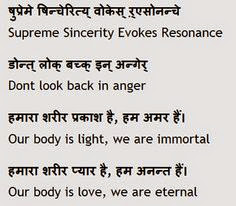You Say Asana, I Say As Is
Yoga 2014. Start date a guess buried in time's antiquity treasure chest. It is difficult to proclaim when legends of beginnings end and factual history begins. Ceaseless fusion of tradition and unfolding future. Discovered new styles to learn or trademarked to declare ownership. Change is an intriguing energy. Some fight it. Some roll with it. Some float to their own current. Yoga's once mysterious benefits revealed by medical, scientific, and psychological discoveries have engraved its ever deepening etch on mankind's historical cave of evolution. It's here to stay...that's for sure.
Debate: To speak Sanskrit or not to speak it...that is the question.
First, a sliver of language history. Sanskrit is one of the first languages of Indo-European descent. It is a classical language of Indian, Hindu, Buddhism and Jainism. It's history of influence on language runs deep and demands years of studying. Patanjali, the designated father of yoga, promulgated one should speak Sanskrit...particularly during any ritual. To speak Sanskrit in that era of time reflected an elevated social and intellectual status. In other words, it distinguished an invisible hierarchy. Learning this inkling of information made me wonder if that is what provokes some to proudly declare they teach speaking Sanskrit as opposed to those who don't.
Some teachers/yoga styles profess all poses should be declared by their Sanskrit name. Very traditional senior citizen branch. Some throw in a few words or don't use any. I've heard through the grapevine not teaching Sanskrit, along with originally outlined structures of poses is not reflective of a true teacher of yoga. Or, rather a teacher who hasn't progressed far enough in their knowledge.
Without trying to sound a bit non-yogi combative, I beg to differ. As aspiring teachers, we hit the books to learn this ancient foreign language as relates to the poses' names, foundation of poses, anatomy, some history of yogis past, philosophy, the 8 limbs and so on. With invested time via studying and practicing, we write our papers, pass test and attain title RYT 200. Good job. We've only just begun.
It's more than words. It's more than moves. It's more than breathing. It's more than formulated sequences. It is a journey of peeling your layers of superficial knowledge off to get to the deeply complex matrix of awareness. And that, my friends, you never stop unraveling. Every time I learn something new, I am reminded I have only scratched the surface. So, I keep practicing the process of learning anything and everything that resonates with my synaptic frequencies.
I think we forget our virginity on the mat. As a naive' yoga student, I recall hearing this unknown language and used my eyes to see the teacher demonstrate what they were talking about. My brain tried to visualize the spelling of the foreign words entering my ears...but couldn't. I just wanted to learn the pose vs. taking a foreign language lesson. The frequent poses, such as Adho Mukha Savasana, Trikonasana, Urdha Mukha Savasana, Tadasana, and of course, Shavasana eventually got ingrained in my brain. But, unknown verbiage mentally distracted me for a few seconds prior to doing the poses. I had to retrieve from my shallow Sanskrit memory bank the pose attached to the foreign word. By the time I got in the pose, the next pose was being announced. Not sure if focused breathing could compete with language interpretation process. I think you get what I'm saying.
With all that said, it is honorable and respectful to recognize the glorious roots of our ever-expanding Tree of Yoga. It is said the roots of a tree are equal to the height of its limbs. How one branches out to water the life giving roots can be as creative as yoga itself. A continuous expansion of the positive energy of yoga's gifts beyond the initially limited group is what we all ultimately seek, right?
Actions speak louder than words.
Namaste'...Om Shanti, Shanti, Shanti...peace, love, and smiles...and whatever else sounds good.

Comments